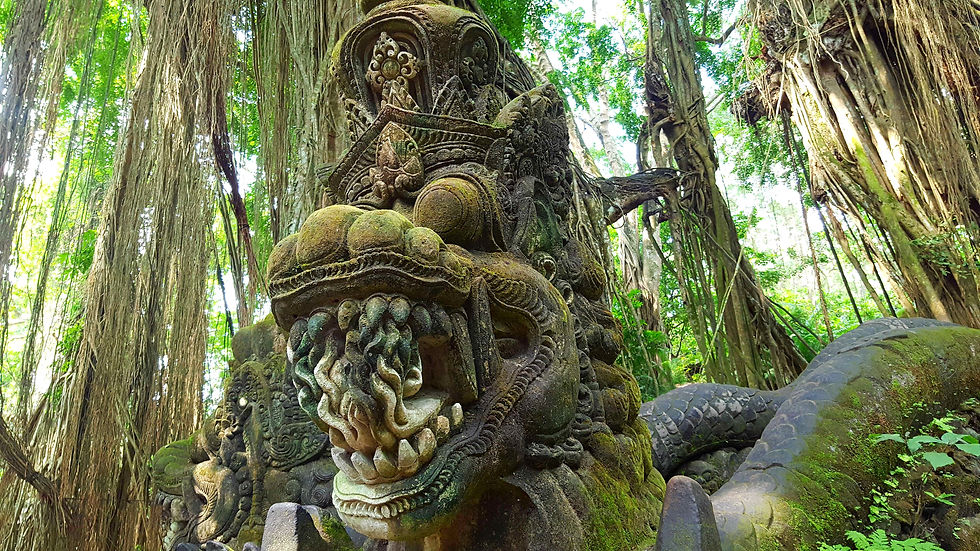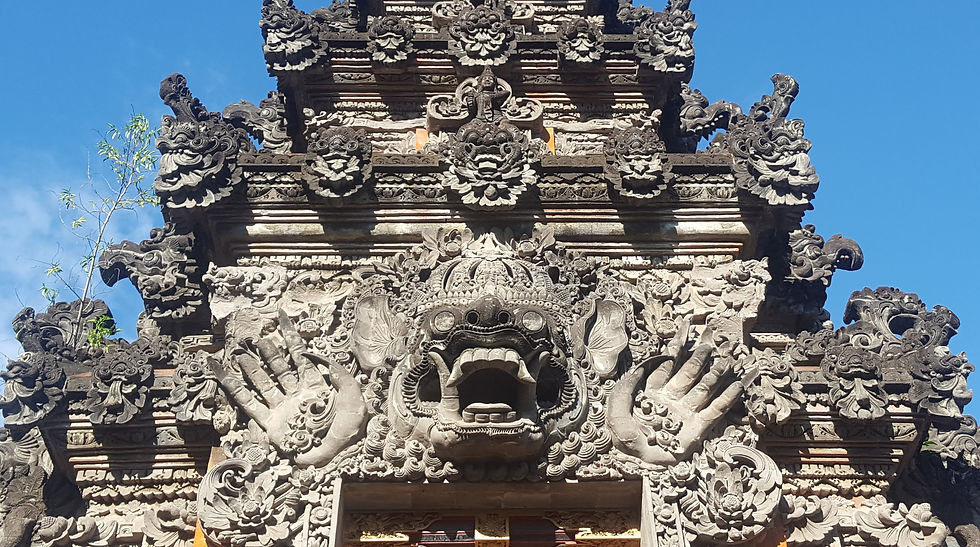The Sacred Nāgas of Bali - Guardians of the Island
- Shannon
- Sep 18
- 4 min read
Bali’s Divine Serpent Guardians
In the mystical landscape of Bali, where volcanoes brood above emerald rice terraces and the sea whispers ancient secrets, serpentine beings known as Nāgas hold a revered place in the island’s cosmology. These mythical serpent deities, often depicted as long, dragon-like creatures adorned with golden crowns and shimmering scales of green and gold, are considered powerful protectors of water, fertility and the spiritual balance between the underworld, earth and the heavens. Though Nāgas are deeply rooted in Hindu and Buddhist traditions across South Asia, where rituals devoted to them have been performed for over 2000 years, the Balinese Nāga has evolved into a distinctly local guardian spirit. Interwoven into Bali’s temples, folklore and ceremonial life, these beings continue to shape the island’s spiritual identity with a uniquely Balinese expression of ancient myth.

Balancing Worlds Through Ancient Customs
In Balinese Hinduism, Nāgas are powerful mythological beings that embody both spiritual energy and elemental forces, playing a crucial role in maintaining cosmic harmony. Among the most revered is Nāga Basuki, the guardian of balance, who is believed to coil protectively around Mount Agung, the island’s most sacred volcano. His presence is frequently invoked in temple architecture and purification rituals, especially at temples located near volcanic springs and sacred water sources. Anantaboga, another foundational Nāga, represents the underworld and the infinite, often imagined as a primordial serpent resting beneath the earth, anchoring the spiritual foundations of the world.

The Island’s Sacred Guardians - Nāgas of Bali
Nāga Taksaka, by contrast, is a sky-linked serpent associated with the element of air and the upper realms. Often depicted as residing at the tops of temples and mountains, such as at Pura Lempuyang, Nāga Taksaka symbolises rainfall, atmosphere and the dynamic balance of nature. Together, they form an elemental trinity, connecting and stabilising the island, anchoring it to the ocean floor and shaping its sacred geography of mountains, rivers and skies, with the belief in preserving the delicate balance between the three realms: the underworld (bhur), the earthly plane (bwah) and the heavens (swah).

The Dragon of Royal Cremation
Distinct from these mythological Nāgas is the Nāga Banda, a dramatic, dragon-shaped effigy used in royal cremation ceremonies, or pelebon. Unlike the bade, the multi-tiered cremation tower used for commoners, the Nāga Banda is reserved specifically for cremating Balinese royalty, particularly those descended from King Dalem Waturenggong, a powerful 16th-century ruler of the Gelgel dynasty. The Nāga Banda is more than a vehicle, it’s a symbolic representation of spiritual bondage. The name itself is derived from Sanskrit, with Nāga meaning serpent or dragon and Banda meaning binding or shackle, highlighting its function as a creature that ties the soul to the material world.
The Sacred Arrow - Taming the Nāga for the Soul’s Journey
During the ritual, a priest shoots an arrow at the effigy, symbolically breaking the Nāga’s grip and allowing the soul of the deceased to ascend to the heavenly realm. The legend behind the Nāga Banda traces back to the tale of Ida Dang Hyang Astapaka, a revered priest who built Tamansari Temple. He is said to have tamed a dragon with a sacred arrow, an act which foreshadowed the liberation of the king’s soul and its journey to Nirvana. This powerful imagery, combining myth, priestly authority and royal lineage, illustrates how deeply the Nāga Banda is woven into Balinese beliefs about life, death and divine transition.

Forces That Anchor the Spiritual Realm
The role of Nāgas in Balinese ritual life is deeply symbolic and highly visible. During major temple festivals, such as Odalan or the great purification ceremony Melasti, elaborately crafted Nāga effigies are paraded in processions to the sea. These rituals are not just symbolic gestures, they are believed to physically purify the village, restore spiritual harmony and renew the connection between the seen (sekala) and unseen (niskala) worlds. Naga representations often flank temple gates or form part of the outer courtyard, reminding devotees of the ever-present balance between chaos and order.

Gateways to the Seen and Unseen
Architecturally, Nāgas are carved into stone stairways, temple balustrades and fountains across the island. A common sight at water temples like Tirta Empul or Goa Gajah is the presence of serpentine sculptures curling around water spouts or temple gates. These are not mere decorations but functional spiritual guardians meant to channel and protect the sacred energy of flowing water, which in Balinese cosmology is a conduit for divine energy (tirtha). In this way, they are associated with both the physical purity of water and the metaphysical purification of the soul. The Balinese Nāgas also represent a localised interpretation of older Indian and Southeast Asian serpent myths. While Indian Nāgas are often feared or respected for their destructive and protective powers, the Balinese versions tend to emphasise balance, guardianship and cooperation with human communities. In some traditional villages, offerings are still made to Nāgas believed to dwell in certain rivers or sacred banyan trees, a nod to the animist beliefs that predate the arrival of Hinduism on the island.


Balancing Life and Death
Local legends around Nāga are both abundant and rich in meaning. In East Bali, some believe that a giant Nāga resides within Lake Batur, guarding the region from drought and disease. Another tale links Nāga Basuki to the formation of the Besakih Temple complex, where his body is said to coil around the mountain to contain its power. These stories, passed down through oral tradition, serve both as moral instruction and environmental reverence, encouraging respect for natural forces and sacred geography.
How Ancient Legends Shape Modern Bali
Today, the Nāgas continues to inspire Balinese art, dance and identity. Whether rendered in shadow puppet theatre or painted in vivid colours across temple banners and ceremonial umbrellas, the image of the Nāga lives on. In an era where modernity and tourism shape Bali’s daily rhythms, the enduring presence of the Nāgas is a powerful reminder that the island’s spiritual foundations are still very much alive. They are not just mythological beasts but living guardians, watchful, coiled and sacred, resting in the heart of Bali’s culture.

Thanks for reading about The Sacred Nāgas of Bali - Guardians of the Island. Check out more awesome legends and amazing destinations here!

Guardians of the Island - The Sacred Nāgas of Bali can be found at temples everywhere















































